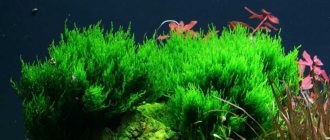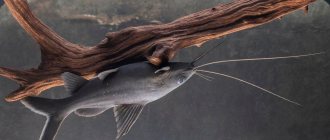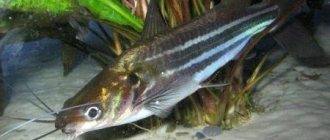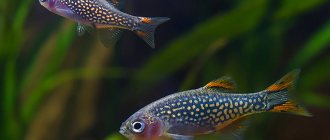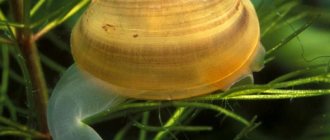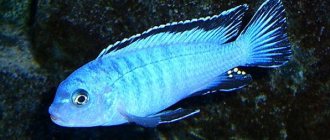The cute aquarium fish Dario dario, also called red badis, was not bred through selective breeding, but is a natural species. Aquarists buy it infrequently; many people do not yet know it at all. Badis scarlet is a gentle fish to care for and maintain, suitable for inexperienced breeders, and thanks to its small size, it feels good in a nano-aquarium.
Badis Scarlet
Red Scarlet or Dario Dario photo
Range: India, Bengal, Bangladesh. It lives in India in clean streams, the bottom of which is covered with sand and often densely overgrown with plants.
Water temperature: 20-26.
Hardness: up to 17.
Size in aquarium: 2.5 cm.
The recommended aquarium volume for an adult is 20 liters.
Badis Scarlet red or Dario dario (Dario dario (Badis sp. Scarlet)) is a very small fish. Bright scarlet vertical stripes are superimposed on the silver-shiny body, and two more thin black strokes pass through the eye. The scales of the scarlet badis are quite large and each of them has a dark border, which creates an artistic oblique mesh on the body of the fish. The fins are also painted bright red, the dorsal and anal are edged with a thin light blue stripe. The same color highlights the rays of the fins, making them voluminous and shiny. Females are grayish-green; you can also see transverse stripes on their body, which are shorter than those of males and do not have an attractive scarlet color. Sometimes females have a slightly red tummy. The fins are transparent or gray, as if covered in haze, as are the eight stripes on the body. The fish has an oblong body with a small head and a neat mouth, with large eyes. All fins of the badis are rounded, except for the pointed pectorals. The dorsal fin is long, and in males it is also wide - if the badis straightens it, the fin will be the same size as the entire body of the fish. Males have large pectoral fins, with slightly protruding first rays. Females have smaller fins. Before spawning, their abdomen enlarges and is rounded at the rear.
Badis Scarlet red or Dario Dario photo
Red badis is a peaceful, hardy fish. It is better to keep them in a species aquarium or shrimp tank in a small flock. Dario is suspicious and wary of his neighbors. There may be a neighborhood with small characins or other small peaceful fish that will not claim a separate and permanent territory. An aquarium densely planted with plants will also be to their taste; the fish will feel comfortable and will no longer be afraid of their imaginary dangers. Males divide the territory of the aquarium into small zones, which they protect. The appearance of a female in this space is considered a marriage proposal, so in a small aquarium, a female who accidentally swims “into the house” of a male and refuses him can get a scolding. Dario dario stay in the middle and lower layers of water, rising to the surface only for a very short time to feed.
Badis Scarlet red or Dario Dario photo
Red badis are predators, so it is better to feed them with small live or special dry food. Feeding aquarium fish should be correct: balanced, varied. This fundamental rule is the key to the successful keeping of any fish, be it guppies or astronotuses. The article “How and how much to feed aquarium fish” talks about this in detail; it outlines the basic principles of the diet and feeding regime of the fish.
In this article, we note the most important thing - feeding fish should not be monotonous; the diet should include both dry food and live food. In addition, you need to take into account the gastronomic preferences of a particular fish and, depending on this, include in its diet food either with the highest protein content or, conversely, with plant ingredients.
Popular and popular food for fish, of course, is dry food. For example, you can constantly and everywhere find food on aquarium shelves - the leader of the Russian market; in fact, the range of food for this Tetra is included as individual food for a specific type of fish: for goldfish, for cichlids, for loricariids, guppies, labyrinths, arowanas, discus, etc. .d. Tetra has also developed specialized foods, for example, to enhance color, fortified, or for feeding fry. You can find out detailed information about all Tetra feeds on the company’s official website - here .
It should be noted that when purchasing any dry food, you should pay attention to the date of its manufacture and shelf life, try not to buy food in bulk, and also store the food in a closed state - this will help to avoid the development of pathogenic flora in it.
Reproduction of badis scarlet . Sexual maturity is reached at the age of 5 months. These fish spawn successfully in a general aquarium, but if you wish, you can put the sweet couple in a spawning tank. When the female is ready, she swims under a leaf or pot, where the male quickly finds her. labyrinths do . At this time, the female sheds eggs, which are immediately fertilized. After a few seconds, everything ends, the fish disperse, and none of the parents remains at the spawning site. Later this process is repeated, and during breaks the male can pursue and even offend the female. By the way, re-laying can occur under a completely different leaf or even in an open place.
Red badis, Scarlet (Dario dario)
Red badis, Scarlet (Dario dario)
General information on Red Badis, Scarlet (Dario dario):
Family: Badium Origin: India, Bengal, Bangladesh Water temperature: 20-26 Acidity: 6.5-8.5 Hardness: up to 17 Maximum size in the aquarium: 1.5-2.5 Habitat layers: Middle, lower Minimum recommended aquarium volume for 1 adult individuals: 20
Additional information on Red Badis, Scarlet (Dario dario): Scarlet is a peaceful, hardy fish. It is better to keep them in a species aquarium or shrimp tank in a small flock. Females should dominate the flock. They prefer a moderately lit aquarium with dense vegetation and shelters. They are a little thoughtful when feeding, which is why it is recommended to keep them separately from active fish. It is better to feed with live, frozen food.
Red badis, Scarlet (Dario dario)
Post by Ilya 72 » July 29, 2021, 07:43 pm
Badis red.
Habitat of red Badis.
It lives in India in clean streams, the bottom of which is covered with sand and often densely overgrown with plants.
Description of Badis red.
Red badis is a very small fish, males do not grow more than 2.5 cm, and females are even smaller. As often happens, all the admiring sighs of aquarists go to the males. Bright scarlet vertical stripes are superimposed on the silvery shiny body, and two more thin black strokes pass through the eye. The scales of the badis are quite large and each of them has a dark border, which creates an artistic oblique “mesh” on the body of the fish. The fins are also painted bright red, the dorsal and anal are edged with a thin light blue stripe. The same color highlights the rays of the fins, making them voluminous and shiny. Females are grayish-green; you can also see transverse stripes on their body, which are shorter than those of males and do not have an attractive scarlet color. Sometimes females have a slightly red tummy. The fins are transparent or gray, as if covered in haze, as are the eight stripes on the body. The fish has an oblong body with a small head and a neat mouth, with large eyes. All fins of the badis are rounded, except for the pointed pectorals. The dorsal fin is long, and in males it is also wide - if the badis straightens it, the fin will be the same size as the entire body of the fish. Males have large pectoral fins, with slightly protruding first rays. Females have smaller fins. Before spawning, their abdomen enlarges and is rounded at the rear.
Contents of Badis red.
Badis is suspicious and wary of its neighbors, so it is better to keep these fish in a species aquarium in a group in which females predominate. If you really want variety, add small characins or other small peaceful fish that will not claim a separate and permanent territory to the badis. They will also like a space densely planted with plants; the fish will feel comfortable and will no longer be afraid of their imaginary dangers. Males divide the territory of the aquarium into small zones, which they protect. The appearance of a female in this space is considered a marriage proposal, so in a small aquarium, a female who accidentally swims “into the house” of a male and refuses him can get a scolding. These fish stay in the middle and lower layers of water and rise to the surface only for a very short time to feed. Badis do not live and delight the aquarist for long, about a year. Temperature 24-26ºC, water can be soft or medium hard (10-20ºdGH). Some aquarists believe that these fish spawn better in slightly harder water. One male and two females need at least 10 liters of water. The fish are hardy and unpretentious, so they can be recommended to beginners.
Feeding Badis red.
Despite their small size, badis are predators, so it is better to feed them with small live or special dry food.
Reproduction of Badis red.
These fish spawn successfully in a general aquarium, but if you wish, you can put the sweet couple in a spawning tank. When the female is ready, she swims under a leaf or pot, where the male quickly finds her. He “hugs” the female from below in the same way as gouramis and other labyrinths do. At this time, the female sheds eggs, which are immediately fertilized. After a few seconds, everything ends, the fish disperse, and none of the parents remains at the spawning site. Later this process is repeated, and during breaks the male can pursue and even offend the female. By the way, re-laying can occur under a completely different leaf or even in an open place. Spawning usually occurs in the morning, the female lays a little eggs every day, so it can be difficult for an aquarist to catch the process itself, as well as to notice small eggs. The female lays the most eggs on the first day, then the number gradually decreases. These fish can eat their offspring, although not very actively, so it is better to put a special protective net on the bottom of the spawning tank. In a community aquarium, the fry are saved by Java moss. Badis eggs are very small, colorless, transparent and stick tightly to the substrate, leaf or soil - in general, wherever they land, they will remain there until full maturity; it will be very difficult to move them. The almost colorless transparent larvae hatch approximately on the second day and simply lie on their sides for some time. A little later, the fry turn over on their tummy, but are also in no hurry to swim, feeding on what floats right in front of their noses. The babies are fed first with live dust, ciliates, then Artemia naupilii and dry powder food especially for fry. Only after 9-10 days the offspring of the scarlet badis begin to swim a little. Sexual maturity is reached at the age of 4-5 months.
Habitat and life cycle features
Dario scarlet can be found in nature in the Indian Brahmaputra River basin. It lives in shallow (up to 1 meter) clean rivers with a sandy or gravel bottom. They can be found there in the upper or middle layers of water among aquatic vegetation near the shore. These fish move slowly and are very timid.
The young keep together, but the adult males fight with each other for territory. During spawning, the male becomes aggressive, can injure or kill other males, and even shows aggression towards females. Puberty occurs at 4-5 months, they live no more than a year.
Important! When deciding to start a fish aquarium if someone in your family suffers from allergies, you need to take some factors into account.
Allergies do not occur to fish, but to their food. To eliminate an allergic reaction, it is important to select high-quality food without the addition of gammarus and daphnia. It is better to give preference to granulated food. Unlike dry food, granules cannot be inhaled. An excellent option would be to buy fish that eat live food.
Dario Dario (Badis Scarlet)
The cute aquarium fish Dario dario, also called red badis, was not bred through selective breeding, but is a natural species. Aquarists buy it infrequently; many people do not yet know it at all. Badis scarlet is a gentle fish to care for and maintain, suitable for inexperienced breeders, and thanks to its small size, it feels good in a nano-aquarium.
Diseases and prevention
How long zebrafish live depends on the quality of food and the purity of the aquarium water. Average life expectancy is 1 year.
The most common problem is fish obesity as a result of overfeeding. With a monotonous diet consisting only of tubifex and bloodworms, pets quickly gain weight and develop serious illnesses that lead to death. Also, fish get sick and die due to toxic damage to aquarium water by rotting food debris.
Prevention consists of proper and varied feeding of pets, avoiding overfeeding, installing a high-quality filter, and regularly changing water.
Dario dario is a cute, calm, non-capricious fish, suitable for inexperienced aquarists. It feels good in a small aquarium and reproduces without problems at home, compensating for its short lifespan.
Description
The genus Dario has recently appeared in the classification of fish; it was identified in 2002 by Ralph Britz. However, the most common species of dario dario has been known since 1822, when it was discovered by Scottish biologist Francis Buchanan-Hamilton.
The fish is small, body length does not exceed 2.5 cm.
Description of the appearance of an adult:
- The body is oblong;
- The head is small;
- The mouth is small;
- The eyes are large;
- The fins are round in shape (except for the pointed pectorals);
- The scales are large, with dark edges, creating a visual mesh effect on the body.
The main external characteristics relate to the color of representatives of the species. Males are brighter and more attractive than females, they have:
- The scales are silvery, iridescent, with vertical red stripes;
- Two thin dark stripes cross each eye;
- The fins are deep red in color, the anal and dorsal fins are decorated with a thin pale blue border.
The coloration of females is much more modest:
- Scales greenish-gray;
- The stripes on the sides are short, gray, barely noticeable;
- Some individuals have a slightly reddish abdomen;
- The fins are transparent with a smoky tint.
Care and maintenance
The optimal volume of an aquarium for a family of one male and three females is 30 liters. Although the fish feel good in a tank of 15 - 20 liters. For a male and 2 females, 10 - 15 liters is enough.
The male divides the aquarium space into several small areas, guards them, and is wary of uninvited guests. The female approaches the male's territory only during the mating season; the rest of the time, accidentally finding herself in an occupied area, she can be punished and expelled by the owner.
Dario prefer to swim in the middle and bottom zones of water, rising to the surface layer only to feed.
Water parameters
Optimal water parameters for dario:
- Temperature – 23 – 26°C;
- Hardness low or medium – 10 – 20°dGH;
- Acidity 6.5 – 7.5 pH.
Badis are not very picky about the parameters of the aquatic environment, but filtration and aeration are required. A third of the aquarium water needs to be replaced weekly.
Fish should not suffer from lack of air. A 30-40 W filter and a compressor device that pumps 30 liters per hour are installed in a 30-liter tank.
Since the fish are tropical, in winter it may be necessary to heat the water to the optimal temperature. For this purpose, buy a special aquarium heater.
Lighting
Under natural conditions, dario live in 10-12 hour daylight hours. The same conditions must be created in the aquarium. If necessary, install additional lighting sources. But the light should be diffused, low-intensity.
Vegetation
Dario feel comfortable in an aquarium densely planted with bottom and floating plants. Vegetation acts not only as decoration, but also as a refuge for small fish.
- Salvinia;
- Vallisneria;
- Thailand fern;
- Hygrophila;
- Cryptocoryne;
- Java moss;
- Anubias.
Decor
When setting up an aquarium, it is important to set aside a place for shelters in which the male will court the female during the breeding season. You can put driftwood, ceramics, and build caves from large stones.
Sand or fine gravel is chosen as soil for the aquarium.
Behavior and Compatibility
The male's behavior towards another member of his sex is aggressive, especially in a small tank. Therefore, a family with only one male should be introduced into a small aquarium. If the tank is large and has a lot of hiding places, then you can purchase several males.
Badis scarlet does not favor its neighbors and tries not to let them into its territory. Therefore, you should not put fish in a common aquarium. Dario has good compatibility only with small peaceful fish. If you want species diversity, and the dimensions of the tank allow it, then you can add small characins. They will not share territory with dario and take food.
Feeding the fish
Dario fish are small predators. In nature, they feed on living microorganisms - small crustaceans, worms, various larvae and other representatives of zooplankton. Small portions of live or frozen zooplankton food are used as food in an aquarium. Sometimes some kibble foods are suitable, but it is best not to feed dry food. Bloodworms, brine shrimp, tubifex, coretra, daphnia, grindal, enchytraeus are suitable.
These tropical fish are prone to obesity. When they gain excess weight, they become prone to diseases due to constant feeding of bloodworms or tubifex. It is better to exclude these components from your daily diet.
Important! A common cause of death for fish is overfeeding. This happens due to food residues, which disrupt the microflora in the aquarium and become quite toxic to the fish. The main signs of overfeeding: cloudy water, the appearance of mold, fungi, algae growth, etc. Therefore, you need to approach feeding the fish responsibly: do not feed them every day and create a feeding schedule, buy high-quality food, install a good filter in the aquarium.
Sex differences
In representatives of the species Dario dario, sexual differences are pronounced. Males are several millimeters larger than females. There are two ways to determine gender: by color and by the shape of the fins.
Males are not only brighter and more beautiful than females, but also have a wider dorsal fin, which when extended reaches the length of the fish’s body. The pectoral fins are large, the first radial bones are elongated. The remaining fins are also larger than those of females.
When spawning begins, the females' abdomen swells and becomes more rounded closer to the tail.
Breeding and reproduction
Dario breed without problems in a joint aquarium, but if desired, you can prepare a spawning tank for a couple.
The female hides under a plant or in a shelter, and the gentleman goes there too. He connects with the female from below. She lays eggs, and the male immediately fertilizes her. The act of merging takes a few seconds, then the fish swim away in different directions. The act is repeated several times, and in the intervals the gentleman usually behaves rudely towards the female, chasing her.
Each time the fish lays eggs in different places. Spawning can be observed most often in the morning. The first clutch is the largest, then the number of eggs decreases. The eggs are small, sticky, transparent, and almost impossible to notice with the naked eye.
Breeding at home is complicated by the fact that darios are capable of eating eggs. Therefore, a net is placed at the bottom of the spawning tank. And if fish spawn in a common tank, then those eggs that are hidden in Java moss are preserved.
The fry appear on the 2nd day. They are transparent and motionless. At first they lie on their side, and when they get stronger, they lie on their abdomen and grab food particles floating by. Only after about 10 days do the fry become active and begin to swim. To feed the offspring, ciliates, live dust, and powdered food for fry are used.
Compatibility with other residents
Being slow in movement and passive in nature, dario fish tolerate loneliness and quiet surroundings well. Males can be aggressive towards each other due to constant competition between themselves. Therefore, it is desirable to have a larger number of females in the aquarium. Since limited space will increase competition between males, it should be sufficient. To live together, they need to select the same peace-loving, small-sized fish. More nimble cohabitants will take away food from the dario, and they may die.

